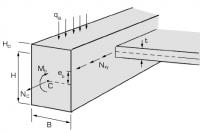Documentation
WinPlates implements for general systems a new very precise finite solution, with the Integrated Force Method. This formulation couples the equilibrium equations and the compatibility conditions to directly solve for the internal forces and moments (curvatures) without an intermediate step of solving for displacements or redundancy.
Be aware that this is a preview of parts of a not yet complete WinPlates documentation
WinPlates is a Windows-based, easy to use interactive program for computation of continuous isotropic and orthotropic (for instance ribbed) plates with or without pliable beams and disc-effect (coupled disc-plate) subjected to concrete, steel or composite concrete and steel.
For general systems, a new very precise finite solution with the Integrated Force Method is developed. This formulation couples the equilibrium equations and the compatibility conditions to directly solve for the internal forces and moments (curvatures) without an intermediate step of solving for displacements or redundancy.
The classical theory of elasticity on thin, coupled disc-plates leads to four simultaneous partial differential equations 2. order with no mixed derivations for the four unknowns, the disc forces Nx, Ny and the moments
Mx, My with Poisson’s ratio 0 (or curvatures as in the complete version) applied at the axis of gravity.
The four basic partial differential equations, 2. order, with general boundary conditions (for instance edge beams with bending and torsional stiffness) are precisely translated by means of developed operators into finite equations which produce excellent and in most cases “exact” results.
Displacements
Displacements are obtained by integration of moments or curvatures and forces. The plates and plates-beams system can be connected to columns.
Plate and beams must be treated as a continuum.
The usual assumption that the middle surface of plates with beams is free from axial forces is an approximation. The favorable effect of the coupled disc-plate is equal to an extension of the beam stiffness by an unknown value. In beams is now beside the moments a normal force with effective shear connection between plate and beam.
Loads
The plates can be subjected to all kind of loads: Arbitrary varying surface loads, concentrated loads and thermal bending and stresses.
The influence of pliable beam support is essential. Usual practice with classical methods assumes rigid support even if the supporting beams are very slim and that leads to completely wrong moment distribution.
Structures consisting of thin plates stiffened by a system of orthogonal ribs have found wide application for buildings, bridges and ships. Plates stiffened in two orthogonal directions, the neutral surfaces in both directions are not at the same distance from the middle surface of the plate. In this case the unknown location of the neutral surface of the bending stresses increases the complexity. The effects of the eccentric arrangement of the stiffening ribs are such that axial forces in addition to the bending moments in the system are considerable, as in the case of a cross-stiffened plate.
Uncoupled plate-disc: and approximation for beams with effective with of flanges according to used code. But this width varies in all beam points with different boundary conditions and loads.
Flat plates
WinPlates also contains very user friendly analytical programs for orthotropic and isotropic flat plates with or without disc-effect and arbitrary placed columns in rows.. Elastic beams can be placed in one direction and with general boundary conditions connected to columns.
Isotropic or stiffened flat plates in the shape of ribbed and “waffle” type slabs are used for floor and roof constructions in buildings.
WinPlates presents an analytical solution for coupled disc-plate, with a stress-function.

